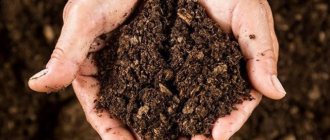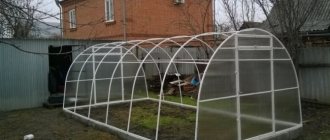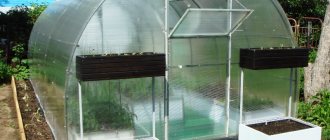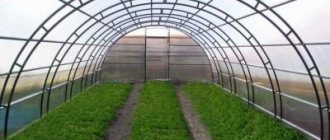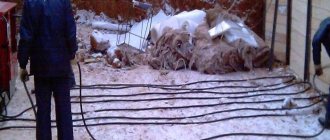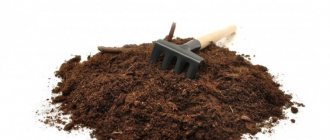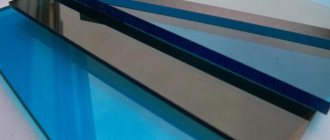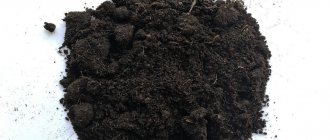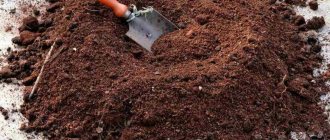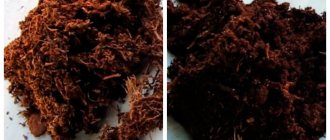What is peat, its composition and properties
Peat is a mineral formed by the decomposition of plants in wetlands.
The humidity in such places is high, and air does not penetrate into the depths of the swamp. Therefore, plants do not decompose completely, forming layers of valuable natural material. Peat composition:
- carbon 50-60%;
- hydrogen 5%;
- oxygen 1-3%;
- nitrogen 3%;
- sulfur 1%.
When burned, peat releases 24 MJ/kg of heat energy. The age of mineral deposits is 5-10 thousand years. But only 60 percent of wetlands produce peat.
Peat properties:
- dark brown or brown color;
- brittle;
- softer than glass;
- lighter than water;
- porous;
- absorbs moisture well;
- combustible.
The use of peat is also common. It is used :
- in the form of fuel: only peat with a medium or high degree of decomposition is suitable;
- in gardening as a fertilizer, for the production of peat tablets and cups for seedlings;
- in livestock farming: it is used as bedding for livestock;
- chemical industry;
- medicine.
Fresh peat is highly acidic and is not suitable for application to the soil, as it has a negative effect on plants.
Lowland peat for blueberries. Preparing the soil for planting blueberries
Blueberries grow in well-lit, acidic soils.
And these are peat bogs, sandy and sandy loam substrates. But, unfortunately, such conditions cannot be found everywhere. If the soil is heavy, it will crack when it dries out in the summer. If you don’t know well what kind of area is in front of you, then it’s better not to plant blueberries. Let's consider some mixtures, for example, high-moor peat; transitional or lowland peat; softwood chips, sawdust, etc. And also cones, small branches from coniferous trees, as well as needles, bark; sand. A productive mixture is undoubtedly high-moor peat with the addition of needles, bark, cones, branches (all one to one) or high-moor peat with approximately 10% sand.
Lowland peat, or transitional peat as it is also called, must be mixed with any components so that the amount of peat itself is at least 40%. If there is no peat, you can take fallen needles, cones, tree branches, and add about 10-20% sand. But the needles need at least 60%. Next, knead the substrate, add 50-60g of sulfur per 1 bush for acidification. It is prohibited to add manure, chicken waste, as well as humus and ash to it. Don’t forget to water the trench and acidify it. But if you add sulfur to the substrate, then the acidification process is not necessary. After all this, you can start planting blueberries.
The time has come to dig a hole, but no more than 100x100cm, the depth should not exceed 20 cm. Then we place formwork about 30 cm high on the hole. We fill it with substrate, but do not forget to leave the last 10 cm of the hole unfilled for mulching. This structure must be protected from the outside from the sun, and in winter from the cold.
You can use other options. For example, we dig a hole 80 cm, depth - 40 cm. We cover the bottom with a film, raise its edges along the wall of this hole by 20 cm. It is necessary to cut the film at the bottom of the hole in several places. After these procedures, the hole can be filled with substrate. But you need to make sure that the edges of the film are raised. This will create a small container in the hole. In this case, water will stick to the film and wet the substrate well, and all excess will pour out through the slots.
If your soil is sand, then there should be enough water for irrigation. The substrate needs to be dug up with the soil more than once. The required area is watered and acidified. After this, she is ready to plant.
This is how you can prepare the soil for planting blueberries.
Types of peat
There are three types of this fossil: high peat, low peat and neutral. They differ in their depth and some properties.
Horse
High peat is formed in the process of interaction and decay of spruce and sphagnum moss with sediments. This top layer is loose, decomposes slowly and contains most of the air.
It is mined in the upper layers of swamps. Often interacts with open air. Mostly composed of sphagnum moss. This moss is light.
Used for the manufacture of filter elements and cleaning systems. Also used as fuel and insulating material.
This peat does not contain weeds and parasites, which is why it is well suited for filling in greenhouses. It is also used as bedding for livestock.
Which peat is better, lowland or high peat? Difference between high and low peat
So, what are the main differences between high-moor and low-lying peat?
High-moor peat consists of plant residues located on the surface of the bog. Accordingly, they are fed from the atmosphere. This type of peat is often called sphagnum peat, since its main component is sphagnum moss. Characterized by an acidic reaction from 2.6 to 3.2 pH. It is characterized by a low degree of decomposition, and high-moor peat cannot boast of a high content of mineral elements. But it is recognized as a durable and quite effective filter. High-moor peat is perhaps the best basis for composing soil for a greenhouse.
Lowland peat differs from highland peat in that it is fed by groundwater. This is the most popular type of peat, since, in principle, it is often used in its pure form. It is characterized by a slightly acidic or neutral reaction of the environment with a pH from 5.5 to 7.0. Lowland peat contains at least 70% organic matter, as well as the entire basic set of nutrients. The beauty of lowland peat is that it can improve even the poorest soil, including even sandy soil, heavy loam and clay. Due to peat, the mineral part of the soil is enriched with organic matter and nutrients, its physical properties are improved by binding sand and loosening clay. At the same time, the acidic reaction of the soil does not change. However, in case of contact with air, lowland peat dries out with subsequent loss of organic matter and nutrients. Therefore, it is recommended to apply low-lying peat directly before digging the soil, and the digging depth should be at least a quarter of a meter. Try to mix the peat with the soil as evenly as possible while digging. This way you will retain organic matter, and the soil will ultimately be homogeneous.
The benefits and harms of peat for soil and plants
Indeed, this substrate can bring not only benefits, but also harm.
Summer residents often add peat in large quantities, without paying attention to what type it is. Thus, they risk damaging the soil and the plants growing on it.
Benefit
- At minimal cost it can improve soil characteristics and increase the amount of harvest.
- The use of peat increases the layer of humus in the soil. The land is becoming more fertile.
- Makes the soil porous, facilitating access of air and moisture to plant roots.
- Able to fight unwanted microorganisms, bacteria and fungi.
- Increases and decreases soil acidity, depending on the type of peat.
- Promotes rapid warming of the soil.
- Stops leaching of nutrients.
- It accumulates moisture, thereby moistening the soil, which is good for dry areas.
Peat plays the role of a natural filter for external and underground waters. It rids it of harmful compounds and heavy metals.
Harm
- If applied incorrectly, in dosage, or in combination with some fertilizers, it can reduce plant growth. Sometimes, unwise use of peat can lead to the death of garden crops.
- May cause increased acidity in the soil. This also negatively affects plants. To reduce acidity, peat is mixed with slaked lime (100 kg of peat and 5-6 kg of lime).
- It makes no sense to introduce peat into fertile and loose soil. It won't do any good. In such soil, only 5% of the nutrients from peat will be absorbed.
Due to insufficient watering, peat clumps can shrink, which will lead to drying out of the plant root system.
High-moor sphagnum peat. 3 Horse
High peat is an acidic sphagnum peat, which is formed mainly on the slopes of watersheds, with a mineral salt content of up to 70 milligrams per liter and an acid value of up to 4.5 pH. In addition to heather, sedge and pine, it contains many mosses, lichens and larches.
Features of high-moor and low-lying peat
High-moor peat is a good and very effective filter. In addition, it is high-moor peat that is best used for greenhouses, as the main soil. Mostly light brown in color, and due to the antibacterial effect of sphagnum, it is ideal for preparing various soil mixtures.
For industrial needs and tasks, various fractions of milled or ground block substrate are prepared. It helps improve the structure of alkaline soils. It can be used for aquariums, as mulch for plant roots, as an antibacterial bedding for animals and birds, for storing crops or bulbous plants.
Deoxidized, that is, neutralized high-moor peat, is used for breeding medicinal leeches, for preparing substrates intended for indoor plants, and for growing various salads.
For example, in the Leroy Merlin chain of stores you can purchase high peat substrates of different crushing fractions, from small (up to 10 mm) to coarse (up to 40 mm), humidity up to 65%, porosity up to 98%, moisture capacity up to 85% and acidity from 5 to 6.2 pH units.
Among the popular products are such substrates as Agrobalt-N, Florio, Klioma-Service, Alantis, Niva and House-Plast. Production facilities are located in Ukraine, Belarus, and Russia.
Main differences
High-moor and low-lying peat have fundamental differences from each other. Based on their characteristics, the scope of use of the fossil also changes. The main differences between the two types of raw materials are as follows:
- acidity is higher in high-moor peat than in low-lying peat;
- riding material is less nutritious;
- In terms of speed of decomposition, lowland peat wins;
- the substrate mined in the lower layers is more saturated with useful substances, therefore it is more suitable as a fertilizer;
- high-moor peat is suitable for surface mulching of the soil, while low-lying peat nourishes it from the inside.
High-moor peat has more acidity than low-lying peat.
In addition to all of the above, the two types of peat may have differences in the places of their formation.
Reviews about manufacturers
There are now increased demands on fertilizers, since products grown on your own plot must be healthy. Every gardener wants to be sure that peat will not bring elements harmful to health onto his plot.
People are looking for high-quality peat fertilizers in order to have not only a large, but also healthy harvest. Conscientious manufacturers try to fully comply with such requirements.
Peat "Buyskie fertilizers"
The Bui fertilizer plant pays great attention to the quality of its products. Its products are very popular among the population. Here are gardeners' reviews of the peat produced at this plant.
Svetlana Nenarokova, Irkutsk
I was able to attend a conference organized by the management of the Bui fertilizer plant. I was convinced that the plant's managers were concerned that only products of excellent quality would be produced.
I saw with what love the workers talk about their business, with what respect they treat their enterprise. When you see such an attitude, you rejoice and understand how valuable it is. I fertilize my dacha plot exclusively with Buyskie Fertilizers peat.
Maria Nikolaevna, Tobolsk
I tried peat produced by the Buysky plant on my plot and fell in love with it with all my heart. This is the best substrate that I have ever bought: homogeneous in composition, without unnecessary impurities and inclusions. I only buy this now.
Tomatoes and cucumbers grow very well. Last year I added peat to potato plantings (peat is a very good fertilizer for plants).
My dacha is blooming, and the whole garden is responding with a wonderful harvest. Thanks to the manufacturers!
Coco peat "Aurica Gardens"
Recently, coco peat has become increasingly popular. Coconut peat is made from the husks of ripe coconuts. The peel undergoes special processing and turns into peat. This soil is sold in pressed briquettes. After getting wet, it takes on a standard appearance and increases significantly in volume.
Domestic gardeners call palm substance peat; in Western countries it is classified as a complete fertilizer.
The advantage of coconut peat is that it is a natural ecological material without impurities or foreign inclusions.
Nikolay Petrin, Penza
I have a small plot of land. I recently discovered such a wonderful peat as coconut peat from. At first I started adding it as fertilizer to flowers. I got an excellent result. I have a lot of flowers, and everyone liked the coco peat, especially the lilies.
Now I add coco peat to all plantings in the garden and garden. I grow tomato seedlings on it. I consider Aurika Gardens to be the best company producing coconut peat.
Tired traveler, Ulyanovsk
I do a lot of flower breeding (including for sale). I consider the most successful coconut peat from Aurika Gardens. You can get good results with it. The product quality is consistently high.
What equipment is needed to produce fertilizers from peat?
To organize the production of liquid humic fertilizers, it is enough to purchase a ready-made set of equipment. On the market you can find BUG units of different capacities. Such a mini-factory can be located in a small room. Or it can work on the street.
You can set up a plant of this type yourself by assembling a unit from simple elements:
- large containers of approximately 3 cubic liters or more;
- heating heating elements and valves for them;
- electric motors.
With proper organization of work, a mini-plant for the production of liquid humic fertilizers can pay for itself in a few months.
How is peat processed into fertilizer?
Peat is processed using a bioactivator - a closed container with an internal environment without oxygen. Bioactivators have valves through which excess methane is released. This gas is formed when peat rots. To make the rotting process faster, heating elements - heating elements - are attached to the containers.
The decay of the biological mass lasts 2–3 weeks, after which the finished fertilizer can be poured into containers.
Production of organomineral fertilizers based on peat
Fertilizers are prepared from peat, which are sold in stores:
- In the form of granules. The granules are prepared using organic and mineral ingredients. During the production of granules, the nutrients from peat become easily absorbed by plants. At the same time, they do not dissolve immediately, but gradually. As a result, plants are nourished, after adding granules to the holes during planting, throughout the entire growing season.
- Humus in liquid form. Peat-based humic fertilizers are easily absorbed by plants. They are enriched with organic matter and can be used for foliar feeding. Humus can be used to stimulate plant growth by soaking seeds in it.
Technology for the production of humic fertilizers from peat
The production of humic fertilizers from peat proceeds in several stages:
- First, the peat is cleaned of excess inclusions that can impair the quality of the fertilizer.
- The peat is crushed.
- Placed in special containers with high pressure and temperature.
- The finished product is purified using a supersonic homogenizer.
- The mixture is placed in a centrifuge to separate by density.
With this type of processing, liquid fertilizer and dry fertilizer are obtained, which can be diluted with water.
Peat-based compost
I’m already used to making healthy peat compost every year with a simple composition:
- peat;
- sawdust;
- plant remains;
- ash;
- manure;
- weeds;
- food waste;
- wood shavings, etc.
I set this up very simply:
- I select an area about 2x2 m away from the house and line it with thick polyethylene.
- I lay a layer of peat 30 cm thick.
- Then - 10 cm of sawdust.
- I mix plant residues with garden soil - this is the next layer (20 cm).
- Then I put a 20-centimeter layer of any manure on the “sandwich” - cow, horse, bird droppings.
- You can continue to form a “sandwich” - again lay down layers of peat, sawdust, plant waste and manure several more times. But I don’t recommend making a pile higher than 1.5 m.
- To ensure a comfortable climate for decomposition of the mass, I cover the sides of the “sandwich” with either the same peat or ordinary garden soil.
- I cover the pile with another piece of strong polyethylene and leave it to “ripen” for 1-1.5 years.
- When preparing compost, I periodically water the pile with a superphosphate solution (100 g per 10 liters of water).
You can make peat compost without layers of manure. But in this case, follow the recommendations:
- Water periodically with slurry (5 kg of mullein per 10 liters of water). It can be replaced with a solution of bird droppings. For fresh mass - 0.5 kg of dry mass per 10 liters of water, for last year's mass - 2 kg per 10 liters of water.
- Be sure to turn the pile upside down at least 2-3 times a year. For uniform “ripening” it is necessary for the upper and lower layers to change places several times.
For any type of cooking, protect the mass from sunlight - I build a light-proof canopy. For the winter, I fill the pile with dry leaves, spruce trees, garden soil, high-moor peat or mulch material. If you have the opportunity to come to the garden in winter, build a “coat” of snow for the peat compost.
According to all the rules, the prepared fertilizer will not be inferior in its properties to manure. If you do not overfreeze or overdry such compost, you will receive the most valuable natural fertilizer. I use it simply, without frills:
- I spread it in an even layer over the area for digging.
- I pour it into the tree trunks of perennial plantings.
The consumption rate is much lower than manure: no more than 1-2 kg per 1 m2. This is explained by the fact that peat compost is more nutritious and contains more useful components in a form that is easily accessible for planting.
What are the benefits of peat for a summer cottage?
The use of peat in a summer cottage leads to positive results. The natural substance is used for the following purposes:
- to improve soil composition;
- to prepare the substrate for planting plants;
- as a basis for the preparation of fertilizers;
- as a covering material in winter;
- in preparing peat blocks for seedlings;
- for lawn treatment, mulching and strengthening.
How should peat be applied? The method is ineffective if you simply scatter the raw materials on the soil surface. To achieve maximum effect, peat material is mixed with turf, humus and other components, then 2-3 buckets are added to an area of 1 m² . This fertilizing can be done every year, which will increase the level of soil fertility by 1%.
Simple rules should be taken into account when applying peat fertilizer at a summer cottage:
- The amount of peat substance in the soil composition should not exceed 70%.
- Before use, be sure to mix it with humus and sand.
- Additionally apply mineral fertilizers.
- Use low-lying peat deposits.
- Use on loams and sandy soils.
The result of fertilizing is influenced by the degree of decomposition of peat raw materials, which should not be less than 30–40%. If a low-lying type of material is used, then it must be ventilated and crushed . At the same time, the material should not be overdried; the optimal humidity should be 50–70%.
Application in the national economy
Peat is a type of organic rock that is formed as a result of the decomposition of organic residues. Contains organic and inorganic compounds, which makes it suitable for use in various fields of human activity.
Peat is used in household plots, as well as in medicine, construction and industry.
Peat is used as:
- energy complex in the fuel industry;
- aromatic material in whiskey production;
- component of mud baths, substrate for the propagation of leeches in medicine;
- fertilizer mixed with other soil elements or separately in agriculture, on personal plots;
- aquarium filter;
- bedding in livestock farming;
- adsorbent and filter for environmental disasters;
- thermal insulation material in construction.
